428021
Latrunculin A
from Latrunculia magnifica, ≥95% (HPLC), solid, actin polymerization inhibitor, Calbiochem
Sinónimos:
Latrunculin A, Latrunculia magnifica
About This Item
Productos recomendados
product name
Latrunculin A, Latrunculia magnifica, Latrunculin A, CAS 76343-93-6, is a cell-permeable marine toxin that disrupts microfilament organization in cultured cells by the formation of a 1:1 complex with monomeric G-actin (KD = 200 nM).
Quality Level
assay
≥95% (HPLC)
form
solid
manufacturer/tradename
Calbiochem®
storage condition
OK to freeze
protect from light
color
white
solubility
DMSO: 25 mg/mL
shipped in
ambient
storage temp.
−20°C
InChI
1S/C22H31NO5S/c1-15-7-5-3-4-6-8-16(2)11-20(24)27-18-12-17(10-9-15)28-22(26,13-18)19-14-29-21(25)23-19/h3-5,7,11,15,17-19,26H,6,8-10,12-14H2,1-2H3,(H,23,25)/b4-3+,7-5-,16-11-/t15-,17-,18-,19+,22-/m1/s1
InChI key
DDVBPZROPPMBLW-IZGXTMSKSA-N
General description
Biochem/physiol Actions
G-actin
Packaging
Warning
Reconstitution
Other Notes
Spector, I., et al. 1989. Cell Motil. Cytoskeleton 13, 127.
Coue, M., et al. 1987. FEBS Lett. 213, 316.
Schatten, G., et al. 1986. Exp. Cell Res. 166, 191.
Spector, I., et al. 1983. Science 219, 493.
Legal Information
Storage Class
11 - Combustible Solids
wgk_germany
WGK 3
flash_point_f
Not applicable
flash_point_c
Not applicable
Certificados de análisis (COA)
Busque Certificados de análisis (COA) introduciendo el número de lote del producto. Los números de lote se encuentran en la etiqueta del producto después de las palabras «Lot» o «Batch»
¿Ya tiene este producto?
Encuentre la documentación para los productos que ha comprado recientemente en la Biblioteca de documentos.
Los clientes también vieron
Nuestro equipo de científicos tiene experiencia en todas las áreas de investigación: Ciencias de la vida, Ciencia de los materiales, Síntesis química, Cromatografía, Analítica y muchas otras.
Póngase en contacto con el Servicio técnico









